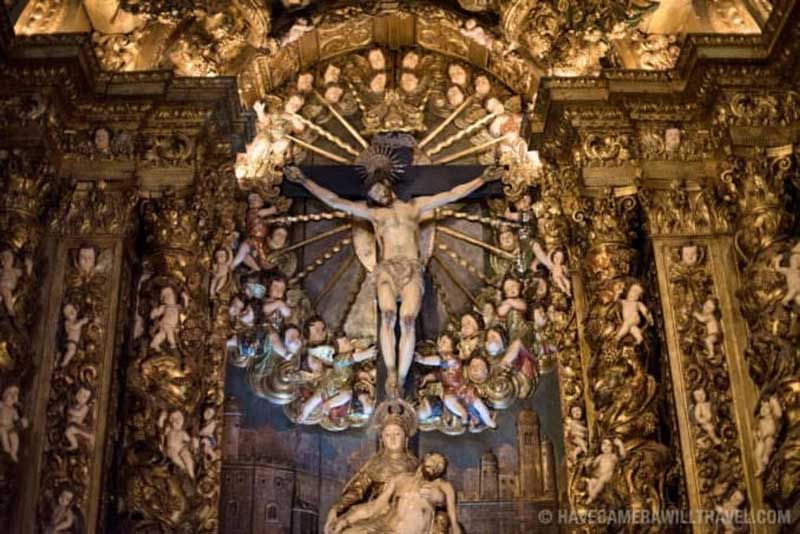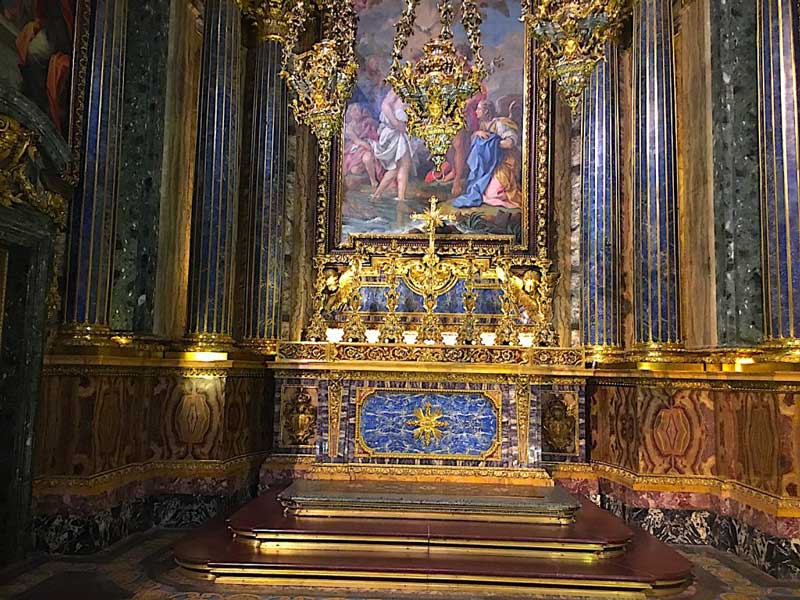
Located on Largo Trindade Coelho, at the corner of a very narrow road, Igreja de São Roque or the Church of St Roch, a Roman Catholic Church in Lisbon, is the earliest Jesuit church in Portugal and one of the oldest in the world. Built in a simple style, called Estilo Chão, its most ordinary façade contrasts with the highly decorated Baroque interior with its glazed tiles, gilt woodwork, multi-coloured statues and oil paintings. It contains eight richly decorated side-chapels, among which the Chapel of St John the Baptist was once known as the world's most expensive chapel. Since São Roque was one of the few buildings in Lisbon to survive the devastating earthquake of 1755, the original wooden ceiling of the church, along with the perspective painting by Francisco Venegas, has been preserved, which makes São Roque one of the most significant churches in Europe.

Igreja de São Roque has a long history behind it. History says, in 1505, Lisbon was ravaged by the fatally infectious plague and even the king was forced to flee the city for a while. During that time, the site of the present São Roque, lying outside the city walls, became a cemetery for the plague victims. At the same time, a relic of St Roch was sent to the city by the Venetian government, whose body had been translated to that city in 1485. On its arrival, the relic was carried in procession up the hill to the plague cemetery and the people of Lisbon decided to erect a shrine on the site to house the relic. As a result, the construction of the proposed shrine begun on 24 March 1506 and dedicated on 25 February 1515. Apart from that, a Brotherhood of St Roch was also established to oversee and take care of the shrine. After the foundation of the Society of Jesus in the 1530s, King John III of Portugal invited them in 1540 and the first Jesuits arrived in Lisbon in the same year. Soon they started looking for a suitable location for the permanent site of their main church and eventually, selected the Shrine of St Roch as their favoured site. After prolonged negotiation, the site was relinquished to the Jesuits, on the condition to include the creation of a chapel for St Roch in the new building and the retention of St. Roch as the patron saint of the new church.

Accordingly, the first stone of Igreja de São Roque was laid in 1555, but the building was redesigned and expanded in 1565. The royal architect, Alfonso Álvares supervised the project until 1575, up to the level of the interior cornice and after that the work was continued by his nephew, Baltasar Álvares. Finally, the building was completed in 1596 by Filipe Térzi, who made modifications to the exterior façade, the ceiling and roof, and the interior finishing. After its completion, the church was dedicated to St Roch, who saved the city and its people from plague and is the patron saint of the hospitals. His symbol is a dog with a bun in its mouth, the impression of which can be found in various places in the church.

The decoration of the Igreja de São Roque continued throughout the 17th and 18th centuries in different phases. The Chapels of St Francis Xavier, of the Holy Family and of the Chancel were decorated in Mannerist or late Renaissance style. While the early Baroque style was reflected in the Chapel of the Holy Sacrament, later Baroque influence is prevalent in the Chapels of Our Lady of the Doctrine and of Our Lady of Piety. The Chapel of St. John the Baptist was adorned in Roman Baroque of the 1740s and the 19th-century renovations include the construction of the choir gallery over the main door where the pipe organ was installed.

The walls of the church, under the choir gallery and in the transept are decorated with diamond-point tiles and elsewhere the tile decoration includes botanical elements, symbols of the Passion and the monogram of the Society of Jesus. The painted ceiling of the nave is designed to give the illusion of barrel vaulting supported by four large arches covered in volutes, spiral or scroll-like ornamentation that forms the basis of the Ionic order, and other decorative elements. Between the arches are painted squared balconies and above those illusions of balconies are three huge domes or cupolas rising on rings of open arches and columns.

Adorned with six Corinthian columns, four arches, round geometric elements and two large carved and gilded side panels with symbolic trees in relief, the throne at São Roque was one of the first permanent ones to be created in Portugal. The four niches of the altarpiece in the Chancel are decorated with the statues of the founders of the Society and its greatest saints namely, Ignatius of Loyola, Francis Xavier, the early Jesuit missionary to India and the Far East, Aloysius Gonzaga and Francis Borgia. Silvered wood statues of the four Evangelists stand in front the altar. The central niche of the lower portion of the altar piece includes a 17th-century statue of the Madonna and the child in upholstered wood, while the upper level is a niche for the exhibition of the Holy Sacrament.

Apart from the Chancel São Roque includes eight main side-chapels, as well as five other altars in the transepts. The Chapels on the right of the nave include the Chapel of Our Lady of the Doctrine, Chapel of St Xavier, Chapel of St Roch and Chapel of the Most Holy Sacrament, originally dedicated to Our Lady of the Assumption and then to Our Lady of the Conception and Relief for Those in Agony. The Chapels on the left include the Chapel of the Holy Family, Chapel of St Anthony, dedicated to St Anthony of Padua, Chapel of Our Lady of Piety, containing the monumental sacrarium with a painting of Our Lady of Pain, along with the lace of angels surrounding the rays from the crucifix and the Chapel of John the Baptist, said to be the most expensive chapel in Europe, which was built in Rome, dismantled and transported by three ships to Lisbon and reassembled in São Roque.

As the Company of Jesus was expelled from Portugal by royal decree in 1768, the Igreja de São Roque and its respective holdings were handed over to Misericórdia de Lisboa. At present, it belongs to the Santa Casa da Misericórdia, a Religious-Charitable Institution that runs the Museum of São Roque, by the side of the church.